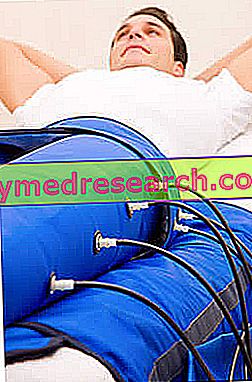Watch the video
X Watch the video on youtubeGenerality
Pressotherapy is a medical and aesthetic treatment, which improves the performance of the circulatory system and the lymphatic system, in those who undergo it.
Find different uses:
- in fighting cellulite blemishes;
- in reducing water retention by lymphedema;
- in redefining certain parts of the body (usually the legs);
- in encouraging the elimination of toxic substances from the body;
- in facilitating the slimming of some parts of the body (in this case, adequate physical activity is also essential).
Pressotherapy involves applying pressure to the area to be treated. To exert this pressure are some kind of pillows, which emit jets of air and with which the therapist covers the patient.

What is pressotherapy?
Pressotherapy is a medical treatment, but above all aesthetic, which improves the functioning of the circulatory system and the lymphatic system, in those who undergo it.
The better functioning of the circulatory system and the lymphatic system assists the natural processes of elimination from the body of toxic substances circulating in the body.
Many dedicated guides describe pressure therapy as a lymphatic drainage technique (or lymph drainage ).
Lymphatic drainage techniques aim to reduce water retention and promote the flow of lymph into its vessels, thus avoiding stagnation in certain areas of the body (usually the extremities).
When you run
Pressotherapy is a remedy indicated for:
- Combat cellulite imperfections.
- Reduce water retention, induced by a condition of lymphedema in the lower limbs. Lymphedema is lymph stagnation in one or more sites of the human body.
Because of pain and swelling, lymphedema can be congenital or acquired over a lifetime. The causes of acquired lymphedema include surgical operations (post-surgical lymphedema).
Pressotherapy is a comfort for those suffering from lymphedema, because it is able to alleviate pain and swelling.
- Redefine the appearance of some parts of the body, especially the legs.
- Encourage the elimination of toxic substances from the body.
- Promote the slimming of some parts of the body, usually the legs. In these situations, it is essential to combine the action of pressure therapy with adequate physical activity and an adequate diet.
- Reduce traumatic edema.
USE IN AESTHETIC AREA
In the aesthetic field, pressure therapy has taken on a prominent role about 15-20 years ago, therefore quite recently.
How does it work?
Functionally speaking, pressotherapy consists in applying an external pressure on the area to be treated, through an instrument designed specifically for this purpose.
The term "pressotherapy" comes from the application of this pressure.
POSSIBLE ANATOMICAL TREATMENT AREAS
In general, the anatomical areas covered by most pressure therapy treatments are the lower limbs and upper limbs .
However, there is the possibility of acting also at the abdominal level, on the back and on the lower abdomen.
The pressotherapy treatments reserved for the legs are by far the most practiced ones.
TOOL
The pressure therapy device includes an electronic device connected to a kind of cushions, which the therapist applies around the anatomical area to be treated.
These cushions are very particular: in fact, through a system of air jets, they exert pressure on the area of interest.
This pressure has an intensity so that there is a reactivation (or a stimulus to a greater activation) of the circulatory system and of the lymphatic system.

For each condition to be treated with pressure therapy, there is a particularly indicated pressure, more effective than others.
Preparation
Pressotherapy does not require special preparation.
The only recommendation given by doctors to patients is to fast, before starting treatment.
Procedure
The pressure therapy procedure is quite simple.
First, the therapist invites the patient to lie down on a special bed.
Then, apply the cushions to the anatomical area of interest and connect these to the electronic device, to regulate the pressure.
A classic pressotherapy session lasts from 30 to 50 minutes .
SENSATIONS DURING TREATMENT
During press therapy sessions, patients experience a sensation similar to that of a massage .
The jets of air and the resulting pressure on the affected area cause this sensation.
MINIMUM NUMBER OF SEATING
Eight (8) is the minimum number of sessions, so that the pressure therapy is effective.
In general, the advice of doctors and experts is to divide the various sessions scheduled into 2-3 appointments a week.
Post-treatment phase
At the end of pressotherapy, many patients feel the need to urinate.
The stimulus of diuresis depends on the mobilization of body fluids, which the treatment induces.
SOME ADVICES
To keep the effects of pressure therapy longer, therapists recommend: adopting a lifestyle that prevents water retention; avoid alcohol; not smoking; reduce salt in the diet; and finally keep the limbs being treated unloaded (when possible).
Contraindications
Pressotherapy has several contraindications.
In fact, according to medical opinion, the subjects suffering from:
- Phlebitis or thrombophlebitis . Phlebitis is an inflammatory condition that affects one or more superficial veins of the upper or lower limbs.
Thrombophlebitis is a form of phlebitis, characterized by the presence of at least one blood clot (thrombus), in the vein subject to the inflammatory process.
Phlebitis and thrombophlebitis are more frequent in the legs.
- Deep vein thrombosis . It is the pathological condition that results from the formation of a blood clot (thrombus) within a deep vein of the body. It usually affects the veins in the legs and can cause unpleasant complications, including death.
Interesting articles about deep vein thrombosis are present here and here.
- Varicose veins . According to the WHO (World Health Organization), varicose veins (or varices) are abnormal and saccular dilatations of the venous vessels. The most affected sites are the lower limbs.
Readers who wish to learn more about the subject can click here and here.
- Severe arteriosclerosis . The term arteriosclerosis indicates the condition of hardening, thickening and loss of elasticity of the wall of small-caliber arterial vessels.
For more information on this, we recommend consulting the article here.
- Diabetes mellitus with microangiopathy . Diabetes mellitus, or more simply diabetes, is a metabolic disease caused by a defect in the secretion and / or action of insulin, a hormone essential for the passage of glucose from the blood to the cells.
Microangiopathy is a complication of diabetes, following an alteration of the capillaries.
To learn more about it and other complications of diabetes mellitus, the reader is invited to consult the articles present here.
- Liver cirrhosis . Liver cirrhosis is a very severe liver disease characterized by death and subsequent replacement of healthy liver cells with scar tissue.
For more information about this, readers can click here and here.
- Renal failure . It is the condition in which the kidneys are unable to perform their functions properly. In fact, therefore, renal failure is a loss of renal function.
For more information on this, it is advisable to click here and here.
- Hepatic failure . It is the term that indicates a serious morbid condition, consequent to a liver irremediably damaged and incapable of fulfilling most of its functions.
To learn about the symptoms of liver failure and other equally severe liver diseases, readers can consult the article here.
- Heart failure . It consists of the heart's inability to pump blood adequately. This means that the body receives less oxygen than necessary, resulting in suffering from parts of various organs and tissues of the body.
To know the causes and characteristics of heart failure, the reader is invited to click here and here.
PREGNANCY
According to some scientific evidence, pressure therapy could represent a danger for pregnant women (both for them and for the fetus).
Therefore, pregnancy is included in the list of situations temporarily contraindicated.
Results
The benefits of pressotherapy are numerous:
- Improves blood and lymphatic circulation.
- Reduces swelling and edema.
- Reduces non-infectious inflammatory states.
- Improves skin oxygenation.
- Improves skin tone and integrity.
- Reduces cellulite with good results and redefines the shape of the legs.
- Reduces post-operative lymphedema with good results.
- Relieves pain induced by some sports injuries.
- Reduces post-traumatic edema.
- Promotes the elimination of toxins and waste products from the body.
- Reduces stress and promotes relaxation.
Thanks to continuous advances in medical technology, pressure therapy is becoming an increasingly effective and recommended treatment.



